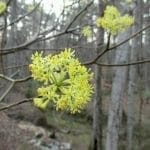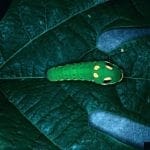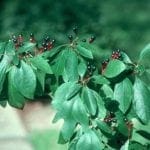2013 Plant Of The Year | Sassafras albidum
Sassafras (Sassafras albidum) is Georgia Native Plant Society’s Plant of the Year for 2013. Sassafras is a deciduous tree that grows in every county of Georgia and is widely distributed over the eastern US. Usually it will be found in open fields, fence rows, rights-of-way, and woodland edges. Sassafras leaves are 3 to 7 inches long and alternate. Often three types of leaves will occur on one tree; entire (oval), two-lobed (like mittens, both left and right hand), and three-lobed (like a fat three-tined fork), earning its common name of Mitten Tree. Kids of all ages enjoy trying to find all of the leaf types on one tree! As the tree matures, the variation in leaf shape decreases until only the oval leaves are present. Another characteristic of sassafras is that all parts of the tree are aromatic.
For untold years, humans have found numerous uses for sassafras trees. Native Americans and early settlers from Europe used it to treat a wide spectrum of medical ailments. Tea was made from the roots; the dried leaves were ground to flavor foods and are still used today as the filé in filé gumbo. The bark was used as a dye for yellow and orange hues, and the wood was used to make barrels, fence posts, and boats. Oil of sassafras was extracted from the inner bark of the roots and was widely used and highly regarded as a restorative tonic. Sassafras oil was used as a flavoring for foods and beverages, including the original root beer. The oil was added to medications to improve their taste, as a flavoring in chewing gum, and as a fragrance in some soaps and perfumes. So great was the oil’s commercial value in Europe in the 17th and early 18th centuries that it became a valuable export during Georgia’s early years. Safrole, one of the constituents of sassafras oil, was found to be a carcinogen in lab animals in the 1960s. Today, safrole can be removed from the oil, and FDA-approved sassafras root extracts are still used to flavor teas, root beers, and other things.
Sassafras is dioecious, meaning that male and female parts are on separate trees. Both sexes are necessary, along with pollinators, to produce fruit. Yellow flowers appear for about one week, April through May, before leaves emerge. Flowers are a bit larger and showier on the male tree, and only the female trees, after pollination by bees and other pollinators, produce the dark blue fruit, a drupe, on stems that become scarlet as the fruit ripens. This fruit is high in fat, so is an important food source for many birds. A female tree usually bears a crop of fruit every 2 to 3 years. As well as being a nectar source for pollinators, sassafras leaves are the larval food source the spicebush swallowtail butterfly, the tiger swallowtail butterfly, and the spicebush silk moth.
Sassafras is easily grown, tolerant of poor soils, drought tolerant once established, and is almost deer-proof. It is shade intolerant and does best in full sun to light shade. Although it tolerates poor soil, it grows best in rich, acidic, well-drained soil. It spreads by lateral root suckers to produce a thicket, but the suckers are easily removed if you prefer an individual tree. Thickets are useful for screening purposes or for massing to increase visual impact. Another appropriate situation for a sassafras thicket is when planting on disturbed sites with poor soil, because after they are established the sassafras will prevent erosion, support wildlife, and look great. Fall color for sassafras can range from intense golden yellow in shadier places to scarlet, orange, and deep reds in sunnier places.
Sassafras grows quickly, up to 3 to 4 feet in height each year for the first ten years if conditions are optimal. Propagation is accomplished by stratified or overwintered seed and by root cuttings. Sassafras is difficult to transplant because of its long taproot and few lateral roots, but will thrive when purchased in containers and planted.
Sassafras is in the Lauraceae family along with redbay (Personia spp.), avocado, and other plants. Redbay is currently threatened with extinction from Laurel Wilt disease, a fungal infection spread by an introduced pest, the redbay ambrosia beetle. Perhaps calling attention to this devastating disease with a better known species like sassafras will increase interest and support for the programs in place to control this pest and the disease it spreads. One of the ways to prevent the spread of this pest is by restricting the transport of infested wood products, including firewood, wood chips, mulch, and wood packing materials from known infested areas. Infested areas are currently in Florida, Georgia, and South Carolina along the Atlantic Coast, and a small area along the Gulf Coast in Mississippi.
In summary, sassafras is a delightful small to medium-sized tree that is underused in home landscapes. It offers great benefits to native wildlife as well as to the humans that either have or plant this wonderful native tree in their yards!
Prepared by Denise Hartline, for the Georgia Native Plant Society.




